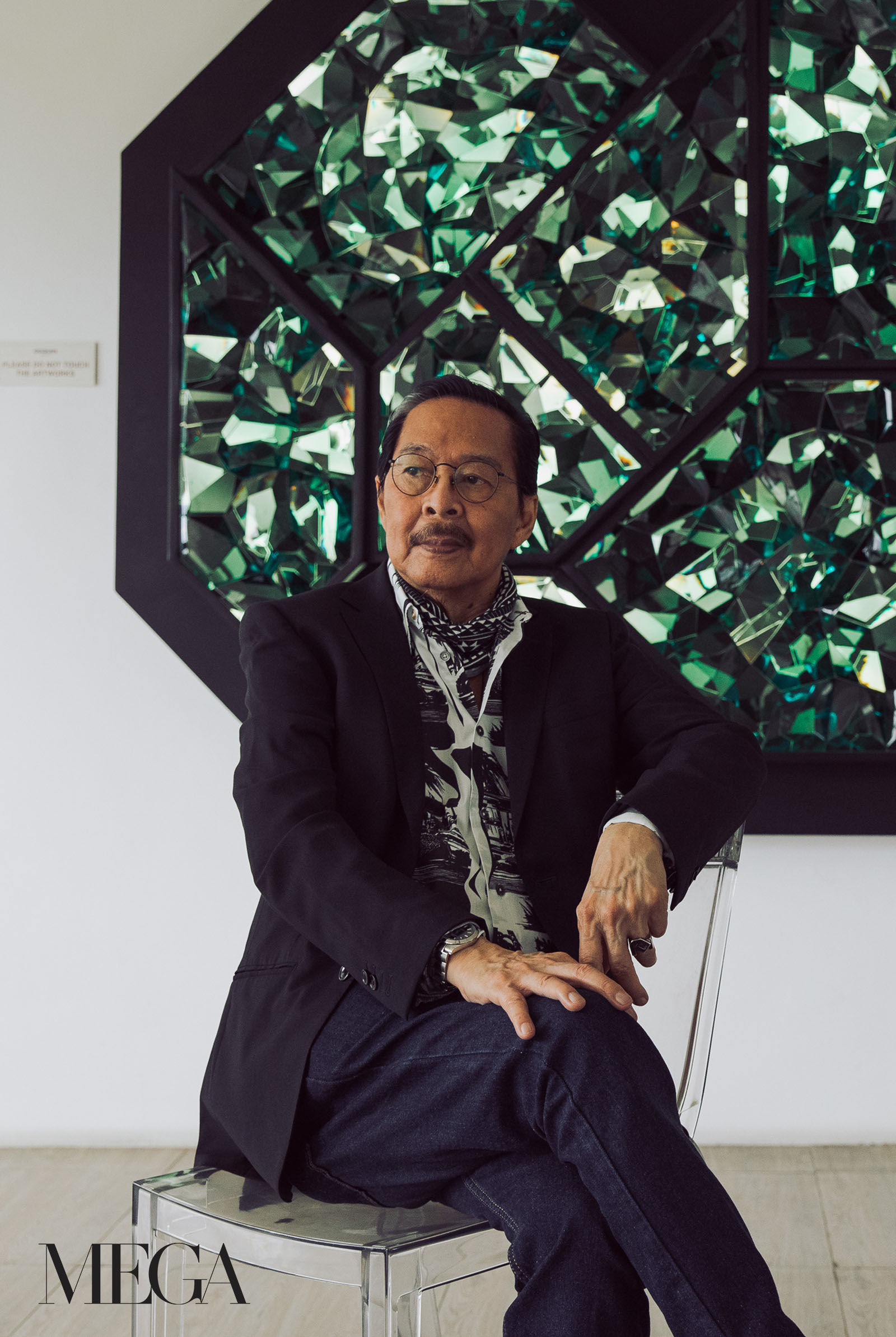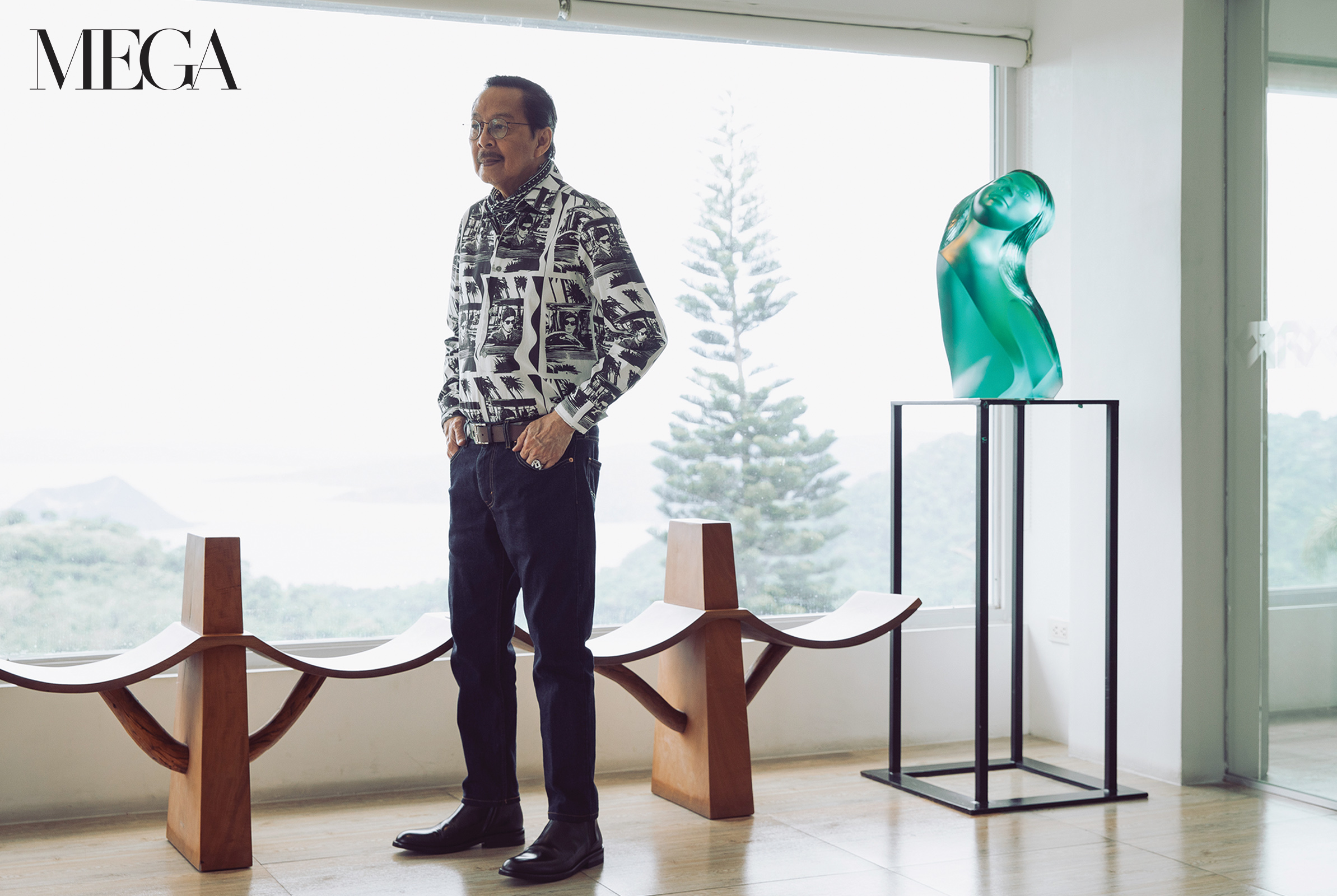In his luminous 76-year career as a contemporary visual artist, Ramon Orlina has explored and redefined glass sculpture as a medium for articulating space, depth, texture, and light. In this exclusive interview with MEGA, the Father of Philippine Glass Sculpture reveals facets about himself that make the legend
This is an excerpt from MEGA’s June 2023 feature story.
The Museo Orlina in Tagaytay is an outstanding art destination south of the Philippine capital. Opened in 2014, it was Ramon Orlina’s dream project, which he built to house beloved works and collections by other artists whose work he admires. He is an architect, trained at the University of Sto Tomas. In his professional practice, Orlina immersed himself in the process of building and constructing structures. “I wasn’t just designing, I did administration work,” he begins. “When I was practicing as an architect, I would really be involved in the construction. It was good training for me. It taught me to build things from scratch.”
A YOUNG RAMON, OLD QUIAPO

From the time he was a child, Orlina was always drawn to new forms and shapes around him. As a young nine-year-old boy, he often accompanied his mother to Quiapo. “She would go there for prayer hour,” he explains. “While she was in Church, I would go around and marvel at the new buildings around the area. There was no such thing as skyscrapers back then like the ones you now see in Makati.”
Around Quiapo, works by National Artist for Sculpture Napoleon Abueva and National Artist for Architecture Angel Nakpil impressed upon his young mind. “These were things from my childhood that inspired me. It made me want to be an artist, a painter, sculptor, and architect. But which one?” shares Orlina. “During these times, the local art scene did have the support it now enjoys. And so the architecture route was the most logical and practical.”
BUILDER OF GLASS DREAMS
Immediately after graduating with a Bachelor of Science in Architecture, Orlina embraced life as a builder. He was keen to learn and master not just the design aspect, but the inner workings of building. “Even when I was still practicing as an architect, I alway leaned towards the use of glass and mirrors. I’ve always found that they create a sense of space and depth. If you think of architecture, it’s steel and glass.”
By the early ’70s, demand for construction and building in the country had significantly dwindled. The political and economic shifts of Martial Law presented Orlina the opportunity to revisit his passion for art.

Immediately, glass was the medium that ignited creativity. His earliest works were two-dimensional, with glass serving as his canvas for enamel paintings. “I began with glass. I showed these pieces to gallerists, most of whom turned me down. They told me to come back after two years.”
In 1975, he held his first solo show at the Hyatt Gallery. Not only was his exhibition well-received, it also introduced him to his early set of patrons. Through this exposition, Orlina also met the leaders behind the country’s sole manufacturer of solid, flat glass, Republic Glass (now Asahi Glass Philippines).
“They appreciated my creative process, which was different from most. I would paint from behind the glass, usually starting with the eyes and painting the face last,” Orlina recalls. “They offered me a scholarship grant to any art school of my liking.” But the young artist felt there was more to learn from going to the glass factory every day. “I told them, ‘Thank you, but I will not be accepting this offer. Would you consider letting me go to your factory every day instead?’”
HIS OWN MENTOR AND MASTER
n an interview with Philippine Star columnist Miguel Ramos last 2002, Orlina introspected: “It was good that I did not study abroad because I was not influenced by anybody. If I studied abroad, I would probably be a second-rate glass-blower. Or I would be casting glass because that’s what I would have learned. I did not have a master. I did not have standards to follow. Nobody taught me. I had to develop my own standards.”

Orlina’s understanding of glass–its properties, capabilities, qualities, and potential—is unlike any other. It has informed his distinct process of cold glass cutting. Only a handful of internationally acclaimed sculptors work with this method, including Sidney Hutter, John Kuhn, Christopher Ries, and Martin Rosol. Within this small circle, Orlina is undoubtedly a pioneer.
“Most work with glass blowing or utilize the hot process,” Orlina observes. Technical proficiency in the unexplored genre allowed him to realize his ideas at scales as massive as 6 x 12 meters. It was his mastery of the medium that helped him dream beyond boundaries. “I studied everything there is to know about glass. From silica to furnace to solvent. From liquid to glass. I did not work on themes until I perfected the material.”
Read more about Ramon Orlina’s artistry and craft in MEGA’s June 2023 issue, now available on Readly, Magzter, Press Reader and Zinio.
Photography JOSEPH PASCUAL
Creative Direction JONES PALTENG
Fashion Direction RYUJI SHIOMITSU
Video Production REGINA ACERON
Videography LORENZO CORRO
Shoot Coordination LAURD SALEN
Sittings Editor BAM ABELLON
The post MEGA Ball 2023 Icon Awardee: Ramon Orlina appeared first on MEGA.
MEGA Ball 2023 Icon Awardee: Ramon Orlina
Source: Insta News Pinoy

0 Comments